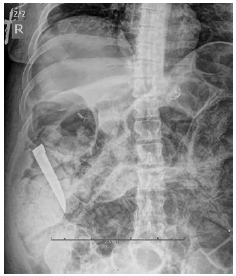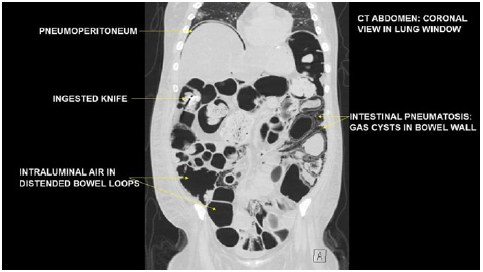ACUPHAGIA: ANESTHETIC IMPLICATIONS
Acuphagia, the practice of inappropriate consumption of non-nutritive sharp metallic substances, is a rare form of pica and can lead to devastating consequences.1 Panel A demonstrates an ingested serrated knife in the right upper abdominal quadrant (Image 1). Panel B exhibits distended bowel loops, pneumatosis intestinalis and pneumoperitoneum on radiological imaging (Image 2).

Source: Authors.
Image 1 Panel A demonstrates an ingested serrated knife in the right upper abdominal quadrant.

CT: Computed tomography. Source: Authors.
Image 2 Panel B exhibits distended bowel loops, pneumatosis intestinalis and pneumoperitoneum on radiological imaging.
Unlike blunt ingested foreign bodies, which frequently pass uneventfully through the bowel, presence of sharp objects in the gastrointestinal tract necessitates urgent endoscopic removal in view of increased risk of viscus perforation. Most gastrointestinal foreign bodies can be extracted endoscopically and surgery is often avoidable. Although pneumoperitoneum and/or pneumatosis intestinalis strongly suggest intestinal perforation or ischemia, need for surgical exploration is determined by presence of peritoneal signs on clinical examination or worsening sepsis.
Anesthetic care may be challenging as oropharyngeal and gastrointestinal tract injury from ingestion of sharp objects complicates airway management. Abdominal distension and ileus increase the risk of aspiration, necessitating a rapid sequence intubation. Odynophagia related to oropharyngeal injury impairs ability to swallow leading to excessive oral secretions. Additionally, bleeding from the upper gastrointestinal tract, occult airway trauma and tissue swelling related to cervical esophageal injury can obscure airway anatomy and glottic visualization. Consequently, intubation via laryngoscopy or fiberoptic bronchoscopy may be difficult while mask ventilation and use of supraglottic devices risks airway soiling. Preparations for emergent surgical airway placement are prudent prior to induction.2 Hemodynamic instability can result from septic shock related to viscus perforation and endotoxemia. Additionally, hypovolemic shock secondary to bleeding and bowel distension induced abdominal compartment syndrome often contribute to hemodynamic instability. Large bore peripheral or central venous access and invasive arterial monitoring should be established prior to induction in critically ill patients. In addition to judicious fluid resuscitation, vasopressors, early antibiotic therapy and protective lung ventilation are valuable in the management of these patients.3











 text in
text in 



